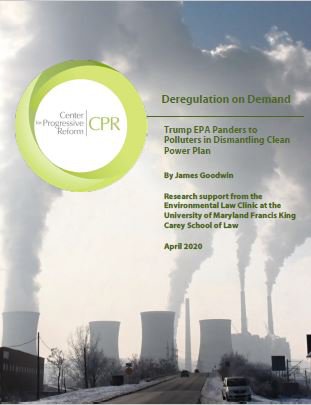
The Final Countdown: Five Years Left Until Chesapeake Bay Cleanup Agreement Deadline
We are five years out from the final 2025 deadline for the Chesapeake Bay cleanup agreement, known as the Bay Total Maximum Daily Load (TMDL). With the approval of the U.S. Environmental Protection Agency (EPA), each of the Bay states has finalized the three required phases of their Watershed Implementation Plans (WIPs). This month, those states have released their draft 2020-2021 milestones, which, when final, will set out the key short-term goals states will work toward, stepping up their restoration work so that they can stay on track to meet their final 2025 pollution reduction goals.
Even though these five-year milestones play an important role in the accountability framework for the Bay TMDL, the WIPs serve as the main vehicle for comprehensively outlining how each state will achieve their commitments. Even the EPA has stated that the WIPs are the "cornerstone" of the Bay TMDL.
Despite this, the final WIPs for Pennsylvania and New York fell short of demonstrating how they would meet their 2025 Bay TMDL pollution reduction allocations. The final WIP for Pennsylvania, for instance, demonstrates that the state will only achieve about three-quarters of its nitrogen reduction allocation by 2025. The state will also suffer a …

June 1 marked the start of hurricane season for the Atlantic Basin. While not welcome, tropical storms, strong winds, and storm surges are an inevitable fact of life for many residents of the Eastern Seaboard and the Gulf Coast. As a new paper from the Center for Progressive Reform explains, with those storms can come preventable toxic flooding with public health consequences that are difficult to predict or control.
In Ernest Hemingway’s 1970 novel, Islands in the Stream, he wrote of his protagonist, Thomas Hudson, “He knew how to plot storms and the precautions that should be taken against them. He knew too what it was to live through a hurricane with the other people of the island and the bond that the hurricane made between all people who had been through it.”
Only Hemingway could romanticize hurricanes. And things have only gotten worse. Last month …

Sometime soon, EPA is expected to release its final rule limiting state and tribal authority to conduct water quality certifications under section 401 of the Clean Water Act. A water quality certification is the most important tool states have to ensure that any federally permitted project complies with state water quality protections.
States often impose conditions on such projects that are more stringent than federal requirements in order to protect drinking water and local aquatic habitat, among other reasons. The Clean Water Act also empowers states to deny certifications and stop a project from moving forward if it would still violate the state's water quality standards even after conditions are imposed.
The rulemaking was spurred by an executive order from President Trump last year. The order directed the EPA to change the 401 certification process, with an ostensible focus on "the need to promote timely Federal-State cooperation …

Earlier this week, we submitted a public comment to the Environmental Protection Agency (EPA), criticizing the agency's March 2020 supplemental proposal for its “censored science" rulemaking. This rule, among other things, would require the public release of underlying data for studies considered in regulatory decision-making, and thus might prevent the agency from relying on such seminal public health research as Harvard’s Six Cities study, which have formed the backbone of many of the EPA’s regulations, simply because they rely on confidential data.
First proposed during the brief and tumultuous tenure of former EPA Administrator Scott Pruitt, the rule, officially known by its Orwellian moniker “Strengthening Transparency for Regulatory Science,” has become a key part of the Trump administration’s assault on the agency’s credibility and authority. Indeed, the arrival of this administration has seen the EPA completely abandon its mission of protecting public health …

On April 17, CPR Board President Rob Verchick joined EPA enforcement chief Susan Bodine and other panelists for an American Bar Association webinar on environmental protections and enforcement during the COVID-19 pandemic. During the event, Bodine expressed "surprise" that the agency's pandemic enforcement policy was so roundly criticized, but she shouldn't have been caught off guard by those critiques.
As Verchick noted during the discussion, "The problem with [weakening monitoring and pollution reporting requirements] is that fenceline communities have no idea where to look. They have no idea if the facilities in their backyards are…taking a holiday from pollution requirements or not."
Verchick added, "Companies don't know what their competitors are doing, and so now you've got companies who might be thinking, oh, well, my competing facilities, maybe they're taking advantage of this and I must, too, because nobody knows who's taking advantage …

During the coronavirus crisis, Dr. Anthony Fauci has become the voice of reason. Much of the public turns to him for critical information about public health while even President Trump finds it necessary to listen. In the Trump era, no one plays that role in the environmental arena. The result is a mindless campaign of deregulation that imperils public health and safety.
We can't clone Dr. Fauci or duplicate the unique circumstances that have made his voice so powerful. However, we can do several things that would make it harder for administrations to ignore science:
- Congress needs to greatly strengthen laws protecting whistleblowers, which currently are much weaker than most people realize.
- Congress also needs to codify into law the existing rules protecting scientific integrity within administrative agencies. Currently there are merely internal regulations that agencies can ignore.
- Either …

If you were the head of the U.S. Environmental Protection Agency (EPA) as news of the coronavirus pandemic hit, what would you do to implement your mission to protect public health?
The best answer has three parts: first, determine what specific categories of pollution could exacerbate the disease; second, assemble staff experts to develop lists of companies that produce that pollution; and, third, figure out how the federal government could ensure that companies do their best to mitigate emissions.
Rather than take that approach, EPA enforcement chief Susan Bodine issued a memo late last month offering businesses assurance that EPA would overlook certain regulatory violations for the duration of the COVID-19 crisis. Public interest groups, already alarmed by the possibility that regulatory rollbacks at the agency would continue at a relentless pace despite the pandemic, were apoplectic …

UPDATE (4/29/20): CPR's Deregulation on Demand paper was recently cited and discussed in an amicus brief filed by Sens. Whitehouse, Merkley, Gillibrand, Schatz, and Markey supporting a case against the ACE rule (American Lung Association v. EPA). You can read the brief here.
Who does the Environmental Protection Agency (EPA) work for? The answer would seem to be us, the American public, given that the statutes it is charged with implementing are focused first and foremost on protecting our health and the natural environment we all depend upon. The Trump administration, however, has transformed this critical protector agency into a powerful of tool of corporate polluters, one dedicated to fattening these industries’ already healthy bottom lines at the expense of the broader public interest.
The evidence of this brazen degree of corporate capture at the Trump EPA abounds. The upper echelons of the agency’s …

Originally published on Expert Forum, a blog of the American Constitution Society. Reprinted with permission.
It has often been observed that natural disasters bring out the best and worst in people. Sadly, with regard to environmental protection, the coronavirus pandemic has brought out the worst in the Trump administration. Using the pandemic as a pretext, Trump's EPA has continued to propose and implement substantial rollbacks in important safeguards to our health and the environment while issuing an unduly lax enforcement policy.
For example, the administration recently issued a final rule rolling back automobile fuel efficiency standards. Its new regulation effectively undoes the federal government's program to limit greenhouse gas emissions. In a severe blow to global efforts to address the climate crisis, the regulation allows motor vehicles driven in the United States to emit almost 1 billion tons more carbon dioxide than would have been permitted under …

With all the talk of the "new normal" brought about by the coronavirus pandemic, we cannot lose sight of how government policies and heavy industry continue to force certain populations and communities into a persistent existential nightmare. Polluted air, poisoned water, the threat of chemical explosions – these are all unjust realities that many marginalized and vulnerable Americans face all the time that are even more concerning in the midst of the COVID-19 pandemic.
Nothing could make these injustices more outrageously apparent and dangerous than EPA’s signaled retreat on environmental standards and enforcement, which cravenly takes advantage of the global pandemic and a rapidly expanding economic collapse. On March 26, Susan Bodine, EPA's Assistant Administrator for Enforcement and Compliance Assurance, issued a memo outlining the agency's sweeping, temporary enforcement policy. Advocates, scientists, and communities almost immediately objected, and in a few days’ time, environmental organizations filed a …







